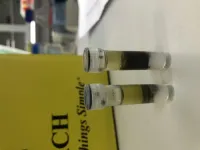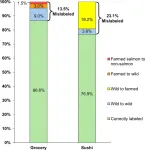(Press-News.org) A study conducted at the Center for Research on Redox Processes in Biomedicine (Redoxoma) helps understand how high blood sugar (hyperglycemia), one of the manifestations of diabetes, can cause thrombosis. The findings, reported in an article published in the Journal of Thrombosis and Haemostasis, can contribute to the development of strategies to prevent cardiovascular dysfunction in diabetics.
“The leading causes of death in Brazil and several other Latin American countries are ischemic events such as heart attacks and strokes, in which arterial thrombosis is a major precipitating factor. These cardiovascular disorders can arise out of several risk factors, such as hyperglycemia, dyslipidemia and hypertension. Among these, hyperglycemia appears to be associated to a significant extent with cardiovascular disease,” said Renato Simões Gaspar, first author of the article.
The investigation was conducted with support from FAPESP during Gaspar’s postdoctoral research and led by Francisco Laurindo, last author of the article. Laurindo is a professor affiliated with the University of São Paulo’s Medical School (FM-USP) in Brazil and a member of Redoxoma, which is a Research, Innovation and Dissemination Center (RIDC) established by FAPESP at the Institute of Chemistry (IQ-USP). Gaspar currently teaches at the State University of Campinas (UNICAMP).
According to the authors, prolonged hyperglycemia and diabetic ketoacidosis are associated with a heightened risk of thrombosis because they cause endothelial dysfunction (alterations to the inner lining of blood vessels), whereby binding of platelets to endothelial cells triggers thrombus formation.
The study showed that peri/epicellular protein disulfide isomerase A1 (pecPDI) regulates platelet-endothelium interaction in hyperglycemia through adhesion-related proteins and alterations in endothelial membrane biophysics.
“We found that a pathway for this PDI in endothelial cells mediates thrombosis in diabetes when hyperglycemia is present, involving a specific molecular mechanism, which we identified,” Laurindo said.
PDI is an enzyme that resides in the endoplasmic reticulum and has the classic function of catalyzing the insertion of disulfide bridges into nascent proteins so that they coalesce in the correct shape, i.e. so that the amino acid chain folds to form the three-dimensional structure that makes the molecule functional. It is also found in the extracellular space as pecPDI, a pool secreted or bound to the cell surface, in various types of cell including platelets and endothelial cells. Studies have shown that pecPDI regulates thrombosis in several models.
Biochemical and biophysical modifications
To investigate platelet-endothelium interaction in hyperglycemia, the researchers created a model with human umbilical vein endothelial cells cultured in different glucose concentrations to produce normoglycemic and hyperglycemic cells and assessed PDI’s contribution using whole-cell PDI or pecPDI inhibitors.
The cells were incubated with platelets derived from healthy donors. The platelets adhered almost three times more in hyperglycemic than normoglycemic cells. PDI inhibition reversed this effect, and the researchers concluded that the process is regulated by endothelial pecPDI.
To obtain a better understanding of the result, they investigated biophysical processes such as endothelial cell cytoskeleton remodeling and found that hyperglycemic cells had more well-structured actin filament fibers than normoglycemic cells. They also measured production of hydrogen peroxide, an oxidizing compound, because reactive oxygen species are mediators of cytoskeleton reorganization and cell adhesion. Hyperglycemic cells produced twice as much hydrogen peroxide as normoglycemic cells.
The researchers then investigated whether cytoskeleton reorganization affected cell membrane stiffness, since substrate stiffness increases platelet adhesion. Using atomic force microscopy, they demonstrated that hyperglycemic cells were stiffer than normoglycemic cells.
The microscope images also showed the formation of cell elongations with extracellular vesicles that appeared to separate from the elongations. This observation led the researchers to investigate the secretome – the set of proteins secreted by an organism into the extracellular space – in order to find out whether it included proteins that enhanced platelet adhesion. “The purpose of this experiment was to detect proteins exclusively expressed by or present in hyperglycemic cells and not in controls or cells treated with PDI inhibitors,” Gaspar explained.
In the secretome, they found 947 proteins, from which they selected eight with a role in cellular adhesion. They then silenced gene expression for three of these proteins using RNA interference and arrived at two proteins, SLC3A2 and LAMC1, as modulators of platelet adhesion. SLC3A2 is a membrane protein, and LAMC1 is the gamma subunit of laminin 1, a key component of the extracellular matrix.
The conclusion was that exposure to hyperglycemia induced secretion of specific adhesion-linked proteins and that PDI and pecPDI inhibition prevented endothelial cells from secreting these proteins.
About São Paulo Research Foundation (FAPESP)
The São Paulo Research Foundation (FAPESP) is a public institution with the mission of supporting scientific research in all fields of knowledge by awarding scholarships, fellowships and grants to investigators linked with higher education and research institutions in the State of São Paulo, Brazil. FAPESP is aware that the very best research can only be done by working with the best researchers internationally. Therefore, it has established partnerships with funding agencies, higher education, private companies, and research organizations in other countries known for the quality of their research and has been encouraging scientists funded by its grants to further develop their international collaboration. You can learn more about FAPESP at www.fapesp.br/en and visit FAPESP news agency at www.agencia.fapesp.br/en to keep updated with the latest scientific breakthroughs FAPESP helps achieve through its many programs, awards and research centers. You may also subscribe to FAPESP news agency at http://agencia.fapesp.br/subscribe.
END
Study shows how high blood sugar increases risk of thrombosis
Discoveries by Brazilian researchers belonging to a FAPESP-supported research center could lead to strategies to prevent cardiovascular disease associated with diabetes
2024-11-06
ELSE PRESS RELEASES FROM THIS DATE:
Cachexia decoded: Why diagnosis matters in cancer survival
2024-11-06
Maintaining good health and well-being is crucial for how well patients respond to cancer treatments. Unfortunately, cachexia, or involuntary weight loss, is a major concern for many individuals with advanced cancer. A new study from Japan has revealed that lower cachexia rates, particularly with prevalence less than 40–50%, are linked to shorter overall survival (OS) rates. The study also showed that the diagnostic criteria used for cachexia detection can affect the reported cachexia prevalence.
People with advanced heart disease or cancer often face serious health challenges. Cachexia, an involuntary loss ...
Transportation institute awarded nearly $1 million in trucking education grants
2024-11-06
Safety is not only for truck drivers, but also the drivers around them.
The Virginia Tech Transportation Institute recently received nearly $1 million in two grants from the U.S. Department of Transportation’s Federal Motor Carrier Safety Administration to develop and enhance tractor-trailer educational programs.
“These two grants will allow us to continue transforming our research into practice,” said Rich Hanowski, director of the institute's division of freight, transit, and heavy vehicle safety. “The outreach initiatives will directly leave an impact on drivers ...
Sewage surveillance proves powerful in combating antimicrobial resistance
2024-11-06
Waterborne diseases affect over 7 million people in the U.S. every year, according to the Centers for Disease Control and Prevention, and cost our health care system over $3 billion. But they don’t impact all people equally.
A campuswide collaboration is using sewage surveillance as a vital strategy in the fight against diseases that spread through the water such as legionella and shigella. The ones that are most difficult to combat are diseases with antimicrobial resistance, which means they are able to survive against antibiotics that are intended to kill them.
A recent paper in Nature Water offers an encouraging insight: Monitoring ...
Natural environment is declining: are companies doing their part to save it?
2024-11-06
The natural environment across the globe is deteriorating, leading to crises like climate change, biodiversity loss, and water scarcity. Companies and industries play a major role in this decline, and they are expected to take responsibility for their environmental impact. A recent study by Probal Dutta from the University of Vaasa, Finland, suggests that companies can meet these expectations by openly sharing reliable, credible information about their activities, environmental performance, and effects on nature.
Probal Dutta’s doctoral dissertation at the University ...
New study sheds light on the role of sound and music in gendered toy marketing
2024-11-06
A groundbreaking study from Queen Mary University of London reveals that the music and soundscapes used in toy commercials are reinforcing rigid gender norms, shaping the way children perceive masculinity and femininity. The research uncovers how gender stereotypes are not only conveyed through visuals and language but are also deeply embedded in the sound and music used in advertisements targeted at children.
For more than 40 years, research has shown how gender polarisation in children’s ...
Pathogens which cling to microplastics may survive wastewater treatment
2024-11-06
Wastewater treatment fails to kill several human pathogens when they hide out on microplastics in the water, reports a new study led by Ingun Lund Witsø of the Norwegian University of Life Sciences, published November 6, 2024 in the open-access journal PLOS ONE.
Wastewater treatment plants are designed to remove contaminants from wastewater, but microplastics persist and can become colonized by a sticky microbial biofilm. Previous research has suggested that these microbial communities, called plastispheres, include potential pathogens, and thus might pose a risk to human health and the environment when treated wastewater and sludge are released.
In the new study, researchers ...
Effects of preterm birth extend into adulthood, study finds
2024-11-06
By analyzing all live births in Canada over a six-year period and following children for more than two decades, researchers found that preterm births and the related cognitive, development and physical health impacts of prematurity are associated with lower income, employment and university enrollment
Individuals born before 37 weeks of gestation, considered to be preterm infants, have, on average, lower employment income, university enrollment and educational attainment through age 28, according to ...
Salmon frequently mislabeled in Seattle grocery stores and sushi restaurants
2024-11-06
In a study of salmon samples from Seattle, Washington, grocery stores and sushi restaurants, DNA analysis revealed that 18 percent were mislabeled. Tracie Delgado and colleagues at Seattle Pacific University, WA, U.S., present these findings in the open-access journal PLOS ONE on November 6, 2024.
Washington State is one of the top suppliers of wild salmon eaten in the United States. The price of salmon depends on the species and whether it is farmed or wild caught. Prior studies have revealed frequent mislabeling of salmon in Washington markets and restaurants. In 2013, the state made it illegal to mislabel salmon, citing negative ...
15,800-year-old engraved plaquettes from modern-day Germany depict fishing techniques, including the use of nets, not previously known in the Upper Paleolithic
2024-11-06
15,800-year-old engraved plaquettes from modern-day Germany depict fishing techniques, including the use of nets, not previously known in the Upper Paleolithic
###
Article URL: https://journals.plos.org/plosone/article?id=10.1371/journal.pone.0311302
Article Title: Upper Palaeolithic fishing techniques: Insights from the engraved plaquettes of the Magdalenian site of Gönnersdorf, Germany
Author Countries: Germany, U.K.
Funding: Deutsche Forschungsgemeinschaft DFG (Germany) - AHRC (UK) Memorandum of Understanding Grant DFG-Projekt GZ: GA 683/13-1 (AOBJ: 647648); AHRC (UK) AH/V002899/1) Kunst und Haushalt im Paläolithikum: ...
How plants evolved multiple ways to override genetic instructions
2024-11-06
Biologists at Washington University in St. Louis have discovered the origin of a curious duplication that gives plants multiple ways to override instructions that are coded into their DNA. This research could help scientists exploit a plant’s existing systems to favor traits that make it more resilient to environmental changes, like heat or drought stress.
The study led by Xuehua Zhong, a professor of biology in Arts & Sciences, was published Nov. 6 in Science Advances.
Zhong’s new research focuses on DNA methylation, a normal biological process in living cells wherein small chemical groups called methyl ...
LAST 30 PRESS RELEASES:
Artificial saliva containing sugarcane protein helps protect the teeth of patients with head and neck cancer
Understanding the role of linear ubiquitination in T-tubule biogenesis
Researchers identify urban atmosphere as primary reservoir of microplastics
World’s oldest arrow poison – 60,000-year-old traces reveal early advanced hunting techniques
Bristol scientists discover early sponges were soft
New study uncovers how rice viruses manipulate plant defenses to protect insect vectors
NSF–DOE Vera C. Rubin Observatory spots record-breaking asteroid in pre-survey observations
Ribosomal engineering creates “super-probiotic” bacteria
This self-powered eye tracker harnesses energy from blinking and is as comfortable as everyday glasses
Adverse prenatal exposures linked to higher rates of mental health issues, brain changes in adolescents
Restoring mitochondria shows promise for treating chronic nerve pain
Nature study identifies a molecular switch that controls transitions between single-celled and multicellular forms
USU chemists' CRISPR discovery could lead to single diagnostic test for COVID, flu, RSV
Early hominins from Morocco reveal an African lineage near the root of Homo sapiens
Small chimps, big risks: What chimps show us about our own behavior
We finally know how the most common types of planets are created
Thirty-year risk of cardiovascular disease among healthy women according to clinical thresholds of lipoprotein(a)
Yoga for opioid withdrawal and autonomic regulation
Gene therapy ‘switch’ may offer non-addictive pain relief
Study shows your genes determine how fast your DNA mutates with age
Common brain parasite can infect your immune cells. Here's why that's probably OK
International experts connect infections and aging through cellular senescence
An AI–DFT integrated framework accelerates materials discovery and design
Twist to reshape, shift to transform: Bilayer structure enables multifunctional imaging
CUNY Graduate Center and its academic partners awarded more than $1M by Google.org to advance statewide AI education through the Empire AI consortium
Mount Sinai Health system receives $8.5 million NIH grant renewal to advance research on long-term outcomes in children with congenital heart disease
Researchers develop treatment for advanced prostate cancer that could eliminate severe side effects
Keck Medicine of USC names Christian Pass chief financial officer
Inflatable fabric robotic arm picks apples
MD Anderson and SOPHiA GENETICS announce strategic collaboration to accelerate AI-driven precision oncology
[Press-News.org] Study shows how high blood sugar increases risk of thrombosisDiscoveries by Brazilian researchers belonging to a FAPESP-supported research center could lead to strategies to prevent cardiovascular disease associated with diabetes








